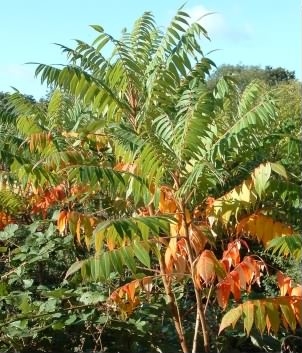
Photo ©2004–
Tree of Heaven - Ailanthus altissima
Family - Simaroubaceae, Quassia Family
Also known as - Chinese Sumach, Ailanthus glandulosa

Photo ©2004–
An introduced species to the UK around 1750 from its native North China, widely planted as an ornamental in towns and cites due to its pollution tolerance, these are usually female trees as the males have an objectionable smell when in flower. It rapidly grows to about 30m (98ft) but mature trees to this height are quite rare due in part to its weak timber, its Latin name is derived from the Chinese for "sky scraping tree". It will mostly be found in the UK as an ornamental planting but in some countries (USA, introduced in 1784), it has become an invasive pest found in wood sides, roadsides, hedges and clearings. Reproduction is by seeds (sexual) and suckers (asexual) from the roots, cut stumps will quickly regrow from the root system.
The compound leaves can be up to 1m (3ft) in length being composed of between 11–25 alternate dark green leaflets turning a golden red during the autumn, with each leaflet having several glandular teeth near the base. Stems and branches are a pale grey, twigs a light brown. Clusters of small yellowish green flowers appear near the tips of branches in late summer in flat papery structures called samaras, it is a prolific seed producer. Wood from the Tree of Heaven is weak coarse grained and soft so mature trees are rare being almost unable to support their full height. The trees aggressive root system can cause damage to sewers and building foundations. Eradication is labour intensive requiring frequent follow up treatment and monitoring unless the trees root system is completely dug up and burnt.
Site design ©1999– Brickfields Country Park - Privacy -